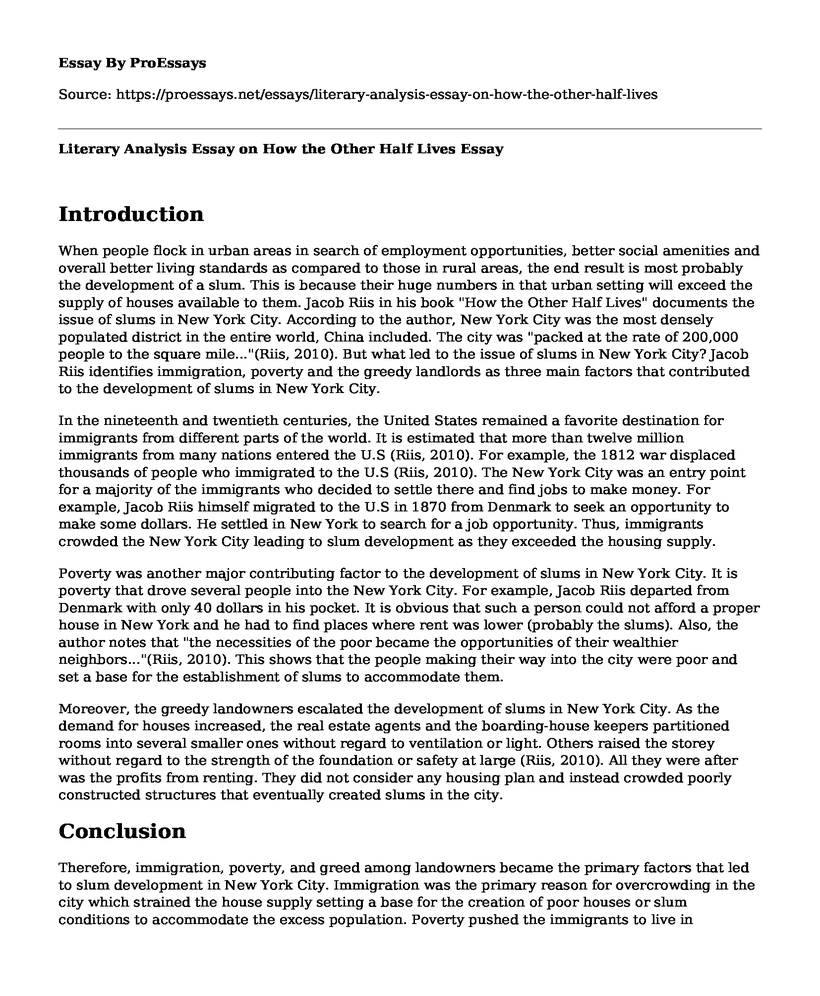Introduction
When people flock in urban areas in search of employment opportunities, better social amenities and overall better living standards as compared to those in rural areas, the end result is most probably the development of a slum. This is because their huge numbers in that urban setting will exceed the supply of houses available to them. Jacob Riis in his book "How the Other Half Lives" documents the issue of slums in New York City. According to the author, New York City was the most densely populated district in the entire world, China included. The city was "packed at the rate of 200,000 people to the square mile..."(Riis, 2010). But what led to the issue of slums in New York City? Jacob Riis identifies immigration, poverty and the greedy landlords as three main factors that contributed to the development of slums in New York City.
In the nineteenth and twentieth centuries, the United States remained a favorite destination for immigrants from different parts of the world. It is estimated that more than twelve million immigrants from many nations entered the U.S (Riis, 2010). For example, the 1812 war displaced thousands of people who immigrated to the U.S (Riis, 2010). The New York City was an entry point for a majority of the immigrants who decided to settle there and find jobs to make money. For example, Jacob Riis himself migrated to the U.S in 1870 from Denmark to seek an opportunity to make some dollars. He settled in New York to search for a job opportunity. Thus, immigrants crowded the New York City leading to slum development as they exceeded the housing supply.
Poverty was another major contributing factor to the development of slums in New York City. It is poverty that drove several people into the New York City. For example, Jacob Riis departed from Denmark with only 40 dollars in his pocket. It is obvious that such a person could not afford a proper house in New York and he had to find places where rent was lower (probably the slums). Also, the author notes that "the necessities of the poor became the opportunities of their wealthier neighbors..."(Riis, 2010). This shows that the people making their way into the city were poor and set a base for the establishment of slums to accommodate them.
Moreover, the greedy landowners escalated the development of slums in New York City. As the demand for houses increased, the real estate agents and the boarding-house keepers partitioned rooms into several smaller ones without regard to ventilation or light. Others raised the storey without regard to the strength of the foundation or safety at large (Riis, 2010). All they were after was the profits from renting. They did not consider any housing plan and instead crowded poorly constructed structures that eventually created slums in the city.
Conclusion
Therefore, immigration, poverty, and greed among landowners became the primary factors that led to slum development in New York City. Immigration was the primary reason for overcrowding in the city which strained the house supply setting a base for the creation of poor houses or slum conditions to accommodate the excess population. Poverty pushed the immigrants to live in deplorable houses that they could only afford. The greedy landowners were driven by the search for profits that they partitioned houses or created poor slum houses to meet the rising housing demands without regard to safety or proper planning.
References
Riis, J. A. (2010). How the other half lives. Macmillan.
Cite this page
Literary Analysis Essay on How the Other Half Lives. (2022, Nov 08). Retrieved from https://proessays.net/essays/literary-analysis-essay-on-how-the-other-half-lives
If you are the original author of this essay and no longer wish to have it published on the ProEssays website, please click below to request its removal:
- Women's Rights and Political Participation
- Romantic Period and Victorian Period Essay
- Film Analysis Essay on Grapes of Wrath
- The Roots of Gender Inequality in Developing Countries Essay
- Goblin Market Poem Analysis Essay Example
- Essay Sample on Childish Gambino's This is America: A Commentary on American Society
- Free Essay Example on Reaction to Drug Dependent Patients







